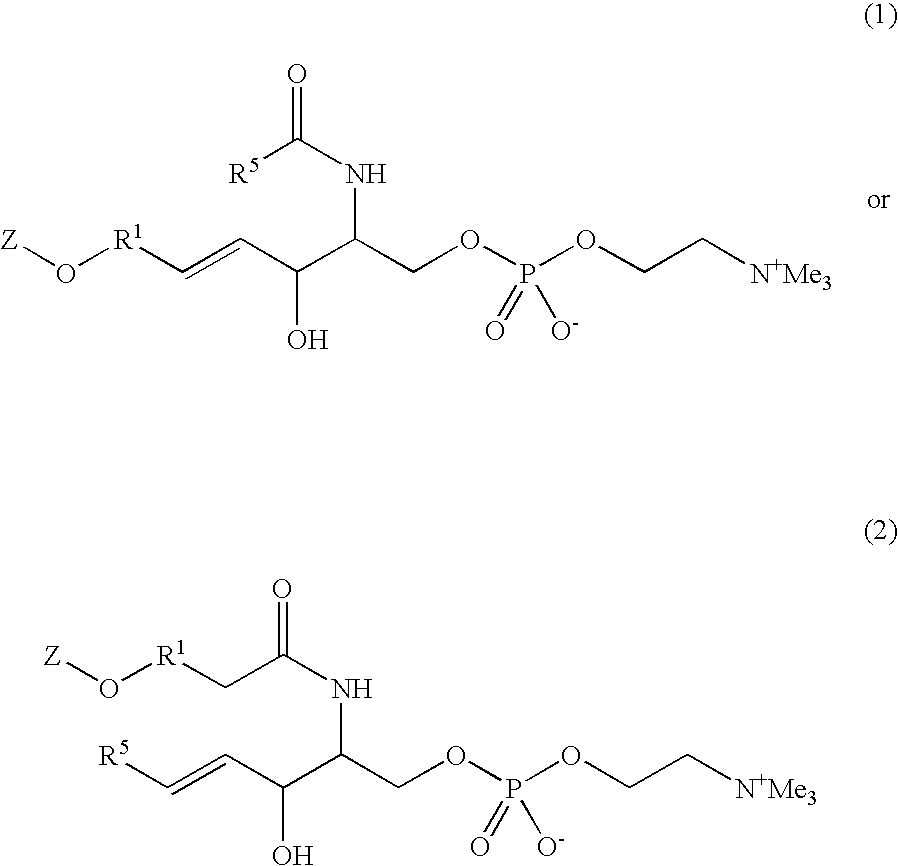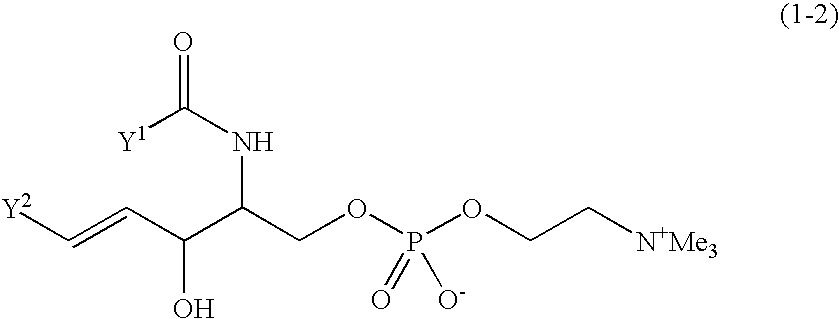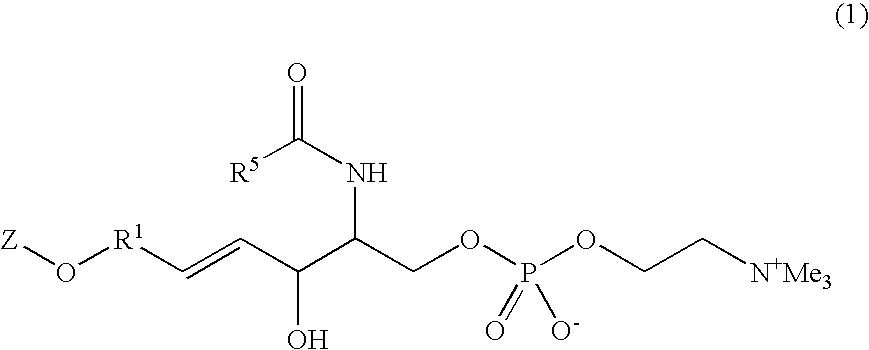Photoaffinity-labeled sphingomyelin analogs and processes thereof
- Summary
- Abstract
- Description
- Claims
- Application Information
AI Technical Summary
Benefits of technology
Problems solved by technology
Method used
Image
Examples
example 2
Synthesis of Acetonide (18)
[0126]To Triol (17) (3.59 g, 9.98 mmol) in DMF (49.9 mL) were added at 0° C., 2,2-dimethoxypropane (3.68 mL, 29.9 mmol) and camphorsulfonic acid (1.16 g, 4.99 mmol), and the mixture was stirred for 4 hours at room temperature. The reaction mixture was cooled to 0° C., followed by adding water and was stirred for 5 minutes. The reaction mixture was neutralized with an aqueous saturated sodium hydrogencarbonate solution, and extracted with ethyl acetate. The organic layer was washed with an aqueous saturated sodium hydrogencarbonate solution, dried over anhydrous magnesium sulfate and concentrated under reduced pressure. The residue was purified with silica gel column chromatography (from 33% to 50% ethyl acetate in hexane) to give Acetonide (18) (3.83 g, 96.1%).
[0127]
[0128][α]D22.0 1.26 (c=0.764, CHCl3) IR (KBr disk): 3402.74, 1687.87, 1514.26, 1170.90, 1014.65 cm−1 1H NMR (CDCl3, 400 MHz) δ: 5.77 (td, J=6.6, 15.4 Hz, 1H), 5.43 (dd, J=7.6, 15.4 Hz, 1H), 4.3...
example 3
Synthesis of N-Boc-4-(3-trifluoromethyl-3H-diazirin-3-yl)-phenoxy (TFDP)-sphingosine (20)
[0129]To Acetonide (18) (2.50 g, 6.26 mmol) in THF (25.0 mL) were added at 0° C. triphenylphosphine (2.46 g, 9.39 mmol) and diisopropyl azodicarboxylate (1.85 mL, 9.39 mmol), followed by adding Phenol (19) (1.90 g, 9.39 mmol) in THF (6.3 mL) at room temperature. After the mixture was stirred for 1 hour, the solvent of the reaction mixture was removed under reduced pressure. The residue was purified with silica gel column chromatography (25% ethyl acetate in hexane) to give crude TFDP-acetonide. To thus obtained crude TFDP-acetonide in methanol (62.6 mL) was added at 0° C. p-toluenesulfonic acid monohydrate (1.19 g, 6.26 mmol) and the mixture was stirred at the same temperature for 1 hour. To the reaction mixture was added an aqueous saturated sodium hydrogencarbonate solution to neutralize it. The solution was concentrated under reduced pressure and the residue was extracted with ethyl acetate. ...
example 4
Synthesis of N-Boc-phosphate (21)
[0132]To carbon tetrabromide (1.37 g, 4.14 mmol) in pyridine (13.8 mL) was added 2-bromoethyl dimethyl phosphite (0.62 mL, 4.14 mmol) at 0° C., followed by adding N-Boc-TFDP-sphingosine (20) (1.50 g, 2.76 mmol). The mixture was stirred for 3.5 hours while gradually rising to room temperature. The reaction mixture was filtered and neutralized with 2N-hydrochloric acid. Then the mixture was extracted with ethyl acetate and the organic layer was washed with 2N-hydrochloric acid, an aqueous saturated sodium hydrogencarbonate solution and an aqueous saturated aqueous sodium chloride solution, successively. The mixture was dried over anhydrous magnesium sulfate, concentrated under reduced pressure and the residue was purified with silica gel column chromatography (from 33% to 50% ethyl acetate in hexane) to give N-Boc-phosphate (21) (1.49 g, 72.4%).
[0133]
[0134][α]D22.0 2.44 (c=1.078, CHCl3) IR (NaCl neat): 3406.60, 1712.94, 1518.11, 1257.70, 1055.16 cm−1 1...
PUM
| Property | Measurement | Unit |
|---|---|---|
| temperature | aaaaa | aaaaa |
| temperature | aaaaa | aaaaa |
| temperature | aaaaa | aaaaa |
Abstract
Description
Claims
Application Information
 Login to View More
Login to View More - R&D
- Intellectual Property
- Life Sciences
- Materials
- Tech Scout
- Unparalleled Data Quality
- Higher Quality Content
- 60% Fewer Hallucinations
Browse by: Latest US Patents, China's latest patents, Technical Efficacy Thesaurus, Application Domain, Technology Topic, Popular Technical Reports.
© 2025 PatSnap. All rights reserved.Legal|Privacy policy|Modern Slavery Act Transparency Statement|Sitemap|About US| Contact US: help@patsnap.com



